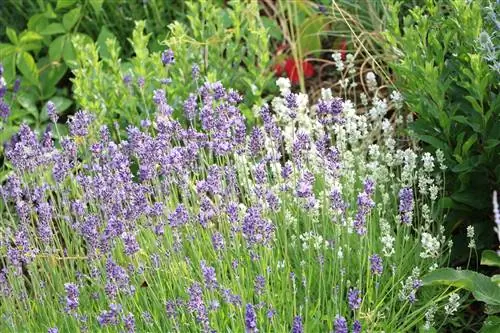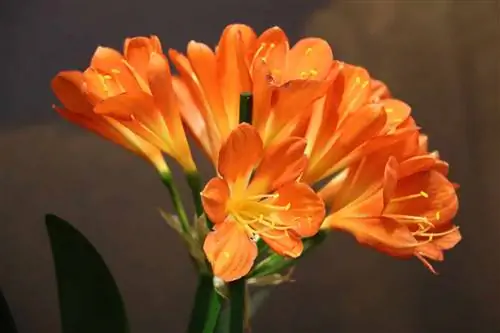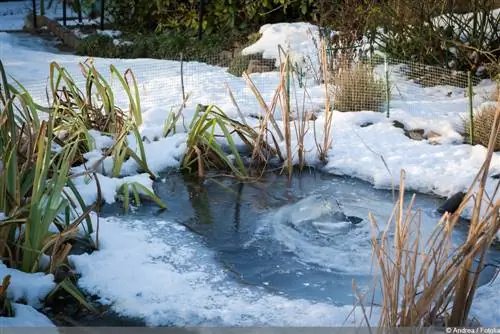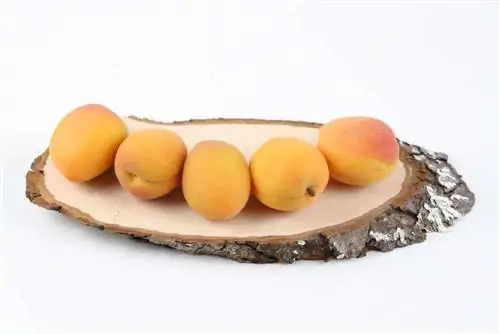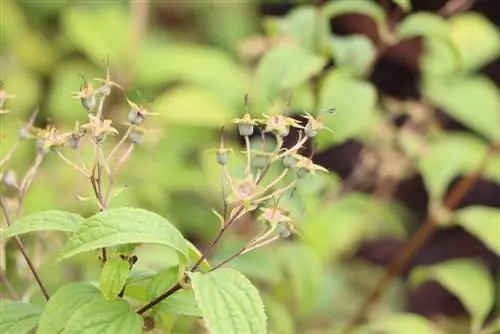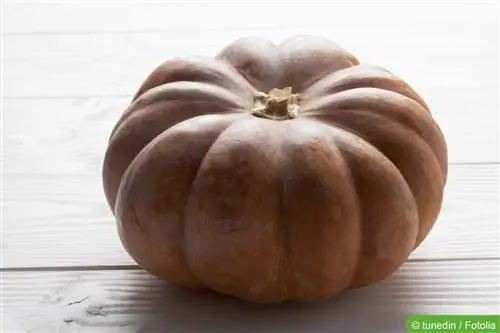- Author admin [email protected].
- Public 2023-12-17 03:39.
- Last modified 2025-01-24 12:45.
The selection of wild-growing perennials for the garden is particularly important. The garden perennials we know today emerged through further breeding. In most cases they surpass their wild relatives in stability, robustness, longevity and flowering ability. You often find the expression 'perennials'. This is a flawed term. Because there are no annual perennials. Annuals are summer flowers or annual plants. Perennials are generally perennial.
A perfectly beautiful garden depends on a balanced combination of perennials, annual summer flowers, shrubs and trees. If the combination is successful, the garden will soon be populated by beneficial insects such as bumblebees, beetles, butterflies, bees, birds and many other species. The garden perennials provide food for many species. This also serves plant he alth, as many beneficial insects fight plant pests. He althy nature protects itself; the use of chemical weapons can be avoided. And if hardy perennials are placed in the right location, they will delight the gardener for many years with their flowering and beauty.
Optimal planting time
Although perennials can now be purchased in specialist stores all year round, the best time for planting is still autumn. The plants have now finished growing. However, the ground is still warm so the roots can still grow. Now the plant can prepare for a good, he althy start to spring. Some frost-sensitive lily varieties are exempt from this rule. These are only planted from March to May.
Prepare the floor
A loosened soil mixed with a little compost before planting provides the right basis. Perennials feel comfortable in loose, humus-rich soil. All weeds should be carefully removed by the roots. Once they grow in the rootstocks of the perennials, they are almost impossible to remove. In order to give weeds no chance, mulching between the perennials has proven effective
Tip:
The planting distance between the perennials should be half the height of the perennials. With a final height of 40 cm, the optimal distance is 20 cm.
Care
The time to care for our perennials begins in autumn. The perennials are now cut off just above the ground. This creates space for new growth next spring. It removes the breeding ground for putrefactive fungi. And this measure prevents the plant from seeding uncontrollably. If the weeds are carefully removed and a thin layer of compost is spread around the perennials, the perennials will get through the winter strong and he althy.
Autumn is also the best time to regulate the size of plants. This becomes necessary after five to seven years and serves to rejuvenate and maintain he alth. To do this, dig up the root ball and divide it into fist-sized pieces with your hands or a spade. At the new location, the small root balls are placed in loosened soil enriched with compost. Press down well and pour in.
Rustic Cottage Garden
Perennials are the most important part of an expressive cottage garden with a natural look. They give the cottage garden its special charm and make the viewer's mind receptive to peace and beauty. Popular perennials for the cottage garden are:
- Columbine
- Beddingstockrose
- Burning Love
- Bush mallow
- Christmas Rose
- Threemasterflower
- Monkshood
- monkshood, blue-white
- Vervain
- Foxglove
- Foxglove, white
- Cinquefoil
- Spring Primrose
- Imperial Crown
- Cat paws
- cockade flower
- Pasque flower, red
- Lampion plant
- Lavender
- Lupins
- Daisies
- Musk mallow
- Peonies
- Phlox
- larkspur
- Primrose
- Coneflower
- perennial sunflower
- Storksbill
- Hollyhock, filled
- Daylily
- Turkish poppy
- Water Dost
- Dwarf Heart Flower
That's what summer smells like
What would a warm summer evening in the garden be without the intoxicating scent of the wonderful fragrant perennials. They exude their scent lavishly and enchant the senses. Even in spring, the scent of lily of the valley and fragrant violets enchants. But summer in particular belongs to the hardy fragrant perennials:
- fragrant violets
- Noble peony
- Feather carnation
- Funkie (Hosta)
- Garden scabiosis
- Gold lacquer
- Catnip
- Lavender
- Lily of the valley
- Mexican nettle
- Musk Alve
- Pentecost violets
- Pentecost violet, speckled
- Peony
- Purple Silver Candle
- Sage
- Stone quendel
- Pigeon scabiosis
- Woodruff
Cut perennials for the vase
When the flowering perennials bloom profusely in the garden, it is a great pleasure to cut flowers for the vase. There are many different types of cut perennials:
- Columbine
- Beddingbellflower
- Umbellbellflower
- Noble peony
- Edelweissmarguerite
- Vervain
- torch lily
- Foxglove
- Flame Flower (Phlox)
- Knapweed, pink
- woman's coat
- Spring daisy
- Garden Hosta
- Garden daisy
- Autumn Anemone
- Imperial Crown
- Tangled Bellflower
- cockade flower
- Pasque flower, white
- Oxeye
- Pechnelke
- Pipegrass
- Magnificent Piers
- Magnificent spar, early
- Giant knapweed
- larkspur
- Red pasqueflower
- Yarrow
- Gypsophila
- Iris
- Summer daisy
- Sun Bride
- Coneflower 'Echinacea'
- Hollyhock, double
- Star umbel, large
- Swamp Sheaf
- Turkish poppy
- Forest Bellflower
- Water Dost
The Rock Garden
An imaginative and naturally landscaped rock garden is particularly popular in our gardens. It expressively embodies nature, is extremely easy to care for and is a real feast for the eyes in every season. Rock garden perennials include:
- Alpine Columbine
- Bearskin Grass
- Blue pillow
- Blue Fescue
- Blood Cranesbill
- Bruchkraut
- Leadwort, Chinese
- Edelweiss
- Honorary Award
- Feather carnation
- Sedum
- Foxglove, white
- Cinquefoil
- Lilac cushions
- Goose cress
- Garden alpine aster
- Garden fat leaf
- Bellflower
- Gold Flax
- Carnation
- Garden cranesbill, gray
- Houseleek
- Heidennelke
- Heidegünsel
- Autumn Cyclamen
- Autumn gentian
- Autumn Magic
- Hungry flower, yellow
- hornwort
- Iceland Poppy
- St. John's Wort
- Carthusian Carnation
- Catnip, high
- Cat paws
- Pillowaster
- Knotweed
- Globe Primrose
- Ball thyme
- Lavender
- Pasque Flower, purple
- Lunchflower
- Cloveroot
- Oxeye
- Pechnelke
- pearl buttons
- Pentecost carnation
- Cushion bellflower
- Cushion saxifrage
- Upholstered phlox
- porcelain flowers
- Heron's Beak
- Rosette Saxifrage
- Red spatula fat sheet
- Sage
- Mockberry
- Gypsophila
- Ribbon flower
- Iris
- Soapweed
- Silberroot
- Summer gentian
- Summer Roses
- Prickly Nuts
- Perennial Middayflower
- Stone quendel
- Stony Seed
- Storksbill
- Carpet sedum, red
- Carpet sedum
- Grape Catmint
- Thyme
- Forest Danemone
- Spurweed
- Zierlein
- Dwarf bellflower
- Dwarf Heart Flower
- Dwarf cushion phlox
- Dwarf Gypsophila
- Dwarf Trollflower
Frequently asked questions
If I cut flowers from 'cut perennials' for the vase, won't the perennials die?
No, cut perennials always produce new flowers and don't mind if the flower stems are cut off. On the contrary, the perennial is encouraged to produce a second flower, which can then last until the end of the growing season.
Why do perennials have to be cut back after flowering?
Pruning promotes the he alth of the perennial. It also encourages a second flowering and self-sowing through seed formation is prevented.
When is the right time to divide perennials?
If the perennial has become too large after five to seven years or is only blooming in some areas, it should be divided. The best time is autumn. The rhizome is removed and divided into fist-sized pieces with a spade. These are placed in a new stand with some humus. Press the pieces down well, pour in and the cycle can start again.
What you should know about bedding plants in brief
Very different plants can be accommodated in beds. There are vegetable beds, fruit beds or flower beds. While flower beds are usually designed to add beauty to the garden, the yields from vegetable and fruit beds can be used for consumption and thus contribute valuable things to your he alth. Depending on which types of bed you prefer, you should make a selection of suitable bedding plants:
- The location of the bed and the condition of the soil play an important role. Is it shady or sunny there?
- Is the soil nutrient-rich or is it lacking in certain nutrients?
- Should they only give joy for one year or should they grow in the same place for several years and perhaps even multiply and enlarge?
These are all important questions that decide in advance whether the bedding plants will thrive.
- Flowers as bedding plants are often only chosen as annual varieties. It's the same with many vegetables and fruits.
- Petunias and geraniums are the most popular bedding plants for the flower bed. The fruit is strawberries and the vegetables are tomatoes.
As the climate here is becoming increasingly milder, bedding plants from warmer regions are increasingly coming in. Today you can find zucchini or eggplants in beds as well as our popular bean bushes and kohlrabi plants.
- The most popular perennial bedding plant is undoubtedly the rose in its diverse shapes and colors.
- Lately it has often been combined with lavender, which fills the environment with a pleasant scent and at the same time provides splashes of color in the bed.
- The large selection of bedding plants ensures that you can find the right bedding plant for every corner of the garden.
- Since bedding plants for the flowerbed come in all sorts of shapes and colors, you can let your creativity run wild.
- Because most bedding plants are annuals, the garden needs to be redesigned every year.
- Beginners and advanced users can also try their hand at bedding plants. Many varieties are robust and do not require much care.
- The only thing you have to bring is the fun of gardening when planting and removing the bedding plants.

